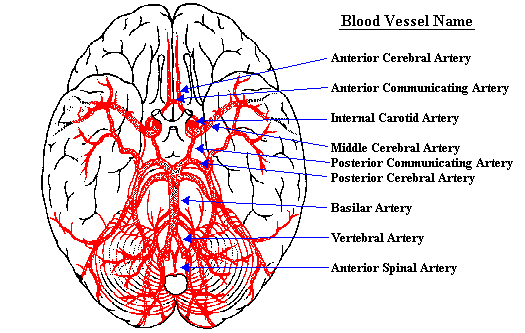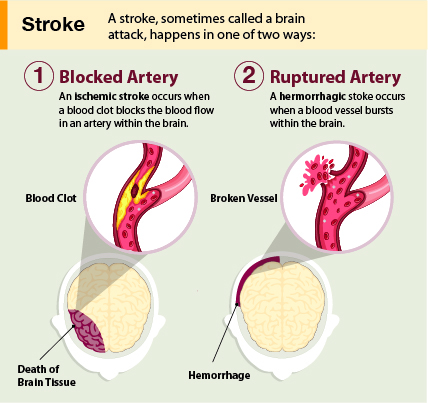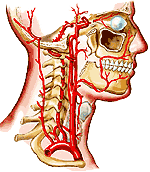2 Neurotechnology for Stroke Rehabilitation
Welcome to the second day of the YSP-REACH Program. Now that you have learned more about neuroscience and neural engineering, you may be wondering how this research can be translated into therapy and treatment. Over the next few days we will focus on different types of neurotechnologies in order to understand how they work and how they are transforming the lives of people with neurological disorders and injuries. Today you will hear from Dr. Azadeh Yazdan-Shahmorad, an assistant professor in the UW Departments of Bioengineering and Electrical and Computer Engineering.
Part One: Brain Blood Flow
Nutrients and oxygen are carried to the brain by many blood vessels. These vessels are found on the surface of the brain and deep within the brain. The blood vessels (and nerves) enter the brain through holes in the skull called foramina.
Although the brain is only about 2% of the total body weight in humans, it receives 15-20% of the body’s blood supply. Because brain cells will die if the supply of blood which carries oxygen is stopped, the brain has top priority for the blood. Even if other organs need blood, the body attempts to supply the brain with a constant flow of blood.
The blood brings many materials necessary for the brain to function properly. The blood also removes materials from the brain.
Blood is supplied to the entire brain by two pairs of arteries: the internal carotid arteries and vertebral arteries. As you can see in the figure, the right and left vertebral arteries come together at the base of the brain to form a single basilar artery. The basilar artery joins the blood supply of the internal carotid arteries in a ring at the base of the brain. This ring of arteries is called the circle of Willis. The circle of Willis provides a safety mechanism — if one of the arteries gets blocked, the “circle” will still provide the brain with blood.
Part Two: What is a Stroke?
You may know someone, a parent or grandparent, who has had a “stroke,” also called a “brain attack.” What exactly is a stroke? A stroke occurs when the blood supply to the brain is stopped. If this happens for enough time, neurons will start to die because they will not get enough oxygen. Paralysis or aphasia (loss of speech) are possible consequences of a stroke.
There are two major causes of a stroke:
1. Blockage of a blood vessel (in the brain or neck) caused by:
- a blood clot in the brain or neck (this is called a thrombosis)
- a blood clot from somewhere else that has moved and now blocks a blood vessel in the brain or neck (this is called an embolism)
- constriction or narrowing of an artery in the head or neck (this is called a stenosis)
2. Bleeding of a blood vessel (this is called hemorrhagic stroke)
There are several warning signs that occur with a brain attack (reprinted with permission from The National Institute of Neurological Disorders and Stroke):
- Sudden weakness or numbness of the face, arm, or leg on one side of the body.
- Sudden dimness or loss of vision, particularly in one eye.

Source: CDC - Sudden difficulty speaking or trouble understanding speech.
- Sudden severe headache with no known cause.
- Unexplained dizziness, unsteadiness, or sudden falls, especially with any of the other signs.
There are several conditions linked to stroke (reprinted with permission from The National Institute of Neurological Disorders and Stroke):
- High blood pressure – Eat a balanced diet, maintain a healthy weight, and exercise to reduce blood pressure. Drugs are also available.
- Cigarette smoking – Don’t start smoking and if you do smoke, quit!
- Heart disease – Your doctor will treat your heart disease and may also prescribe medication to help prevent the formation of clots.
- Diabetes – Treatment can delay complications that increase the risk of stroke.
- Transient ischemic attacks – These are brief episodes of stroke’s warning signs and can be treated with drugs or surgery.
Try it!
In this Day 2 Padlet, think of some technologies or therapies that might help people who have had a stroke. These might even be technologies that have not yet been developed; be creative with your ideas.
Then, hit the “back” arrow on your web browser to return to this chapter and keep reading.
Know it! F.A.S.T. Warning Signs of a Stroke
Remember the letters in F A S T to spot a stroke:
F = Face Drooping: Does one side of the face droop or is it numb? Is the person’s smile uneven?
A = Arm Weakness: Is one arm weak or numb? Does one arm drift downward when the arms are raised?
S = Speech Difficulty: Is speech slurred?
T = Time to call 911
Watch This!
- Watch this video to see how stroke affects the brain.
Find out more!
Learn more about stroke and its diagnosis, symptoms, and treatments.
- Read About Stroke from the American Stroke Association
- Read Stroke Information Page from the National Institute of Neurological Disorders and Stroke
- See Brain Images after a stroke
The ability of the brain to modify its neural connections, form new neural connections, or re-wire itself throughout an individual’s lifetime. This happens through learning and memorization and due to the immense neural connections–the neural network–between cells in the human brain. Neuroplasticity occurs during brain development when the brain processes sensory information from infancy through adulthood. Neuroplasticity also occurs as an adaptive mechanism; for example, in the case of brain injury, the brain may compensate for lost functions or amplify remaining functions.
Holes in the skull that allow the passage of nerves and blood vessels.
A communication pathway linking neural signals from the brain with an external device. The neural signals are decoded by a computer using an algorithm that translates the signals into a motor output (action), such as controlling a neuroprosthetic hand or steering a wheelchair. BCIs may operate using either EEG or ECoG recordings or single unit activity from neurons. Also called a Brain-Machine Interface or a Brain-Control Interface.


